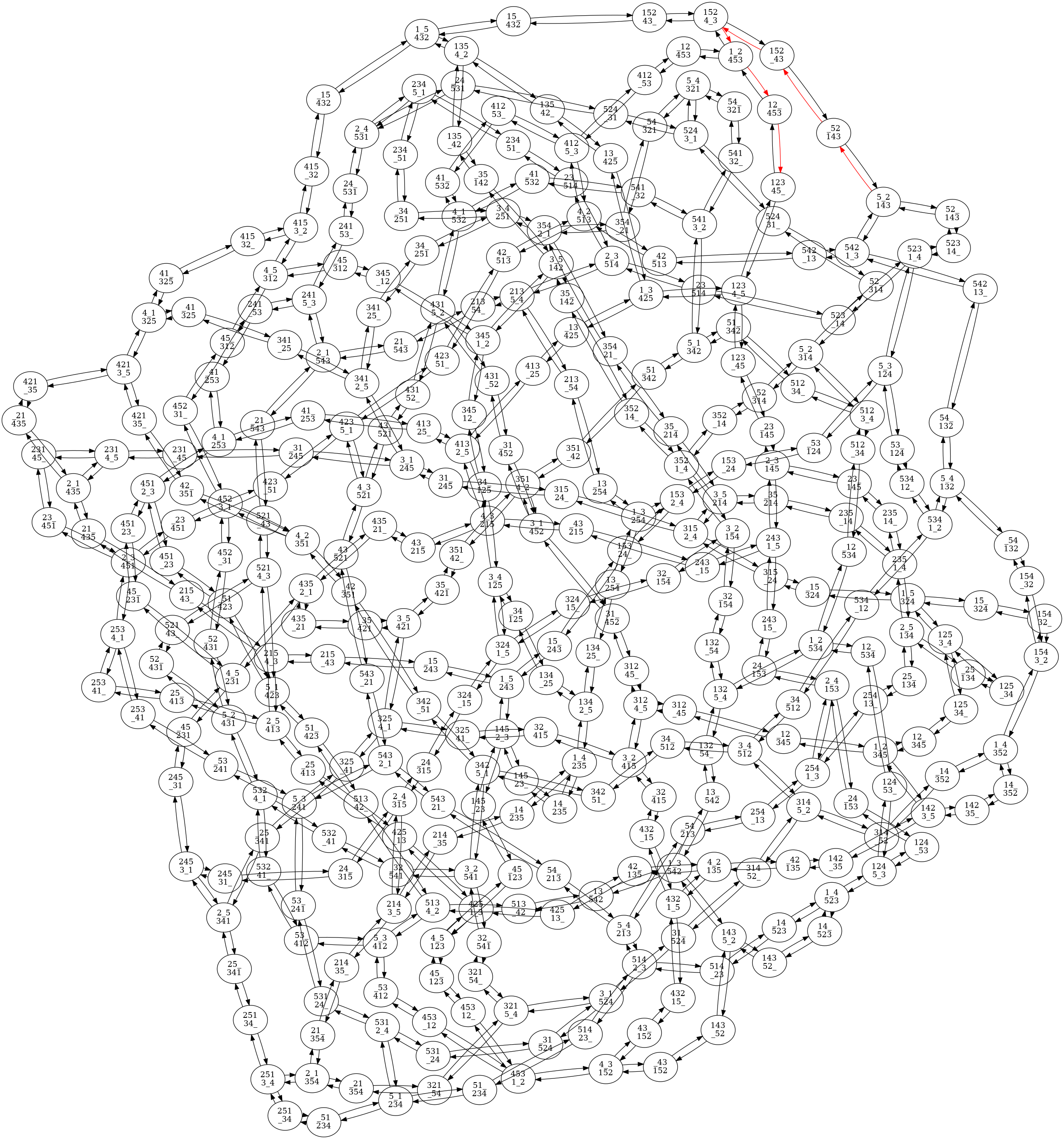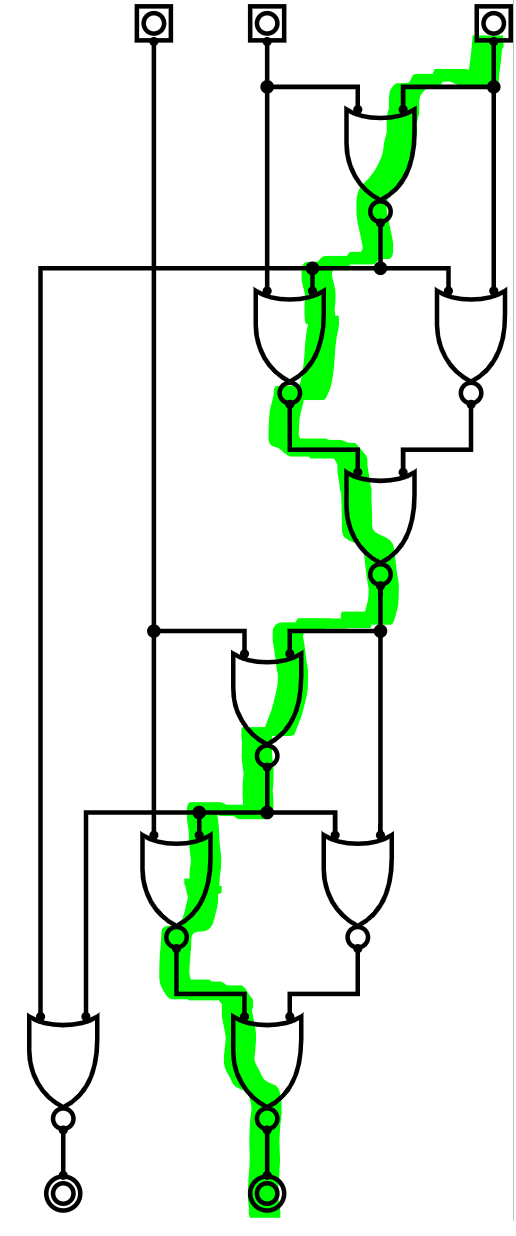Assignment 6: Path Length
Objectives
- to work with graphs
- to implement graph search algorithms
- to implement a dynamic programming algorithm
Introduction


Source: Wikipedia user Trex4321 via Wikipedia
In general, there can be many simple paths (paths with no repeated vertices) in a graph between any pair of vertices. In many applications, we are interested in the extremes, for example the simple paths with the most or fewest edges. For example, we can represent the states of a puzzle as vertices in a graph, with a directed edge if it is possible to move from one state to another in a single step; the path with the fewest edges from the vertex representing the initial state of the puzzle to the vertex representing the goal state then represents the solution with the fewest steps. And in a graph representing a combinational circuit with vertices representing inputs, outputs, and logic gates, and edges representing connections between those inputs, outputs, and gates, the longest simple path plays a large role in determining how fast the circuit can produce its output.
Overview
Complete a program calledPaths that will read the
number of vertices and a list of the edges
in a directed graph from a file and will compute and display the lengths
of the shortest or longest simple paths between pairs of vertices. The name
of the file to read and which paths to compute will be given as
command-line arguments. For example, if
the file graph_6.in contains
6 0 1 0 2 0 3 2 1 3 2 3 1 4 0 4 5 5 0 5 4then running
./Paths graph_6.in -shortest 4 1 -longest 4 1 -shortest 0 1 -longest 0 1 should result in the following output:
[jrg94@tick ~]$ ./Paths graph_6.in -shortest 4 1 -longest 4 1 -shortest 0 1 -longest 0 1 -shortest: 4 ~> 1: 2 -longest: 4 ~> 1: 5 -shortest: 0 ~> 1: 1 -longest: 0 ~> 1: 3
The Paths executable
The paths.c from /c/cs223/hw6/Optional contains
a main that handles input and output, relying on an implementation
of a directed graph ADT in the ldigraph module to compute
the lengths of shortest and longest simple paths. You should not need to modify this
file. There is also a makefile in that directory that you may use to build
the executable.
Implementing the ADT
In order for the code in paths.c to work, you must
complete the adjacency-list implementation of the directed graph ADT
in the ldigraph.c file from /c/cs223/hw6/Optional/.
You will have to complete the digraph_bfs function that is
called by digraph_shortest_path and also complete the
digraph_longest_path function. The latter function should
call modified versions of digraph_dfs in order to
topologically sort the graph if possible. If the topological sort is
possible, then the longest path between the two given vertices can be
found in $O(n+m)$ time by dynamic programming. Otherwise, you should
use another modified version of digraph_dfs to find the
longest simple path by finding every possible simple
path between the given vertices.
Your functions must execute in the following worst-case asymptotic time bounds.
-
ldigraph_shortest_path: $O(n + m)$ -
ldigraph_longest_path: $O(n + m)$ when the graph is acyclic, $O(n \cdot n!)$ otherwise.
malloc and
free run in $O(1)$ time.
Your implementation of the search functions may assume that there is enough heap space available to allocate a constant amount of space per node in the graph for a reasonable constant.
Details
User input is handled by the providedpaths.c, so you needn't worry
about these details except to create your own test cases.
Graph specification
- the first line of the file contains a non-negative integer in a format
readable by
atoigiving the number of vertices in the graph - the rest of the file contains one line per edge
- each edge is given as the index of the source vertex and the index of the destination vertex, separated by a single space
- there are no duplicate edges
- each vertex index is between 0 (inlcusive) and the number of vertices in the graph given on the first line (exclusive)
- there are no self-loops (edges from a vertex to itself)
Command-line arguments
- The first command-line argument is always present and gives the name
of the file containing the graph specification or is the
string
-timing. If the name of a file, that file will be readable and in the format specified above. - If the first command-line argument is
-timingthen the last two command-line arguments give a graph size as a positive integer readable byatoiand either 0 or 1 indicating whether to process the remaining command line arguments or not (0 means don't process). - The remaining command-line arguments occur in groups of three. Each group
of three arguments starts with either
-shortestor-longestto indicate whether to compute the length of the shortest or longest simple path, and then contains the indices of two valid vertices in the graph in a format readable byatoi.
Output
- There is one line of output per group of path specification arguments.
- Each line starts with
-shortestor-longestas specified by the corresponding argument, then gives the indices of the starting and ending vertices, separated by~>, then has a colon and the number of edges in the computed path. Spacing is as in the above example. - Path length is reported as -1 if there is no path.
Submissions
Submit your completedldigraph.c and any other
source code you created or modified that is necessary to build the
Paths executable.
If you did not modify the files from /c/cs223/hw6/Optional then
you need not submit them.
Your makefile can assume that those supporting files have been copied
into the current directory, but should not assume they
are still in their original locations.